
Components

- Playing board
- 109 cards
- 12 British town discs
- 9 French town discs
- 12 fortification discs
- 18 British village cubes
- 18 French village cubes
- 2 Siege strength
- 1 British siege location marker
- 1 French siege location marker
- money
- 2 Player Aid cards per language
- rulebook
The Board


Each player has a series of named spaces on his side of the board which are used to hold cards. At the start of the game each player will shuffle and place his initial draw deck face down in the Draw Deck space.
Your location cards should be placed in your Available Location Cards space. They do not need shuffling as you will be taking cards from here as a result of settling and winning sieges. It is recommended that you sort the cards into alphabetical order to make it easier to find the required card.
Your empire cards should be placed in your Available Empire Cards space. Once again, these do not need shuffling, as you will be selecting cards from here at your discretion rather than randomly drawing them.
As you play cards you place them on to your discard pile. When your draw deck is exhausted you shuffle your discard pile to make a new draw deck. The British and French Siege Card spaces are used to place cards that have been used in a siege.
The Cards
There are two card types, location cards and empire cards. Location cards have a named location on them. All cards without a location named on them are empire cards. Cards also come with five different border colors.
Those with a deep or light red border can only be used by the British player. Those with a dark or light blue border can only be used by the French player.
Cards with a green border are neutral and can be used by either player. The deep red and dark blue bordered cards are also the initial draw decks for the British and French players.

Card Symbols
Many of the cards have a parchment area at the bottom which contains text and/or symbols. The text will explain the action/s that can be carried out by the card. The symbols vary in their use/employment as explained below:

Bateaux - a card with this symbol on can be played to allow you to travel along a river or lake.

Wagon - a card with this symbol on can be played to allow you to travel along a road.

Ship - a card with this symbol on can be played to allow travel by sea. It can also be used to add to your strength in a siege if the besieged location has a ship symbol next to it.

Fur - a card with this symbol on can be used in conjunction with a trader card to earn money (two money per fur card played).

Settler - a card with this symbol on can be played to allow you to settle a location that also has this symbol in it. It can also be used to develop a village into a town.

Ambush - a card with this symbol on is vulnerable to being ambushed.

Money - a card with this symbol on can be played to earn the amount of money shown in the coin.

Military strength - a card with this symbol or symbols on can be played to add to your strength in a siege. Each such symbol on the card is worth one strength point.
Important Note: The British and French players do not have identical sets of location cards. Many of the British locations do not appear in the set of available French location cards. Where locations card do occur in both sets, they may have the same or different connections and may have different symbols.
Setup
Each player should select a side and take the corresponding wooden pieces and cards. Each player should have:
- An initial draw deck (dark red/blue border).
- An available location card deck (light red/blue border).
- An available empire card deck (light red/blue border).
You shuffle your initial draw deck and place it face down in your draw deck space. Your location cards and the empire cards should be placed face up in the spaces indicated. These decks do not require shuffling.
The neutral empire cards (green border) should be placed face up by the side of the board so that each type of card can be clearly seen (it makes sense to stack cards of the same type to save table space). Place the money by the side of the board to form a bank. The French player starts with five money and the British player starts with twelve money.
Each player starts with a number of cubes and discs on the board, which represent settled locations. Cubes represent villages and discs represent towns. Certain locations are already colored red and blue, to indicate which side they are initially controlled by. T
he British player should place one cube in each red square location and one disc in each red circular location. The French player should do likewise in each blue location. Having a cube or disc in a location indicates that you control it.
Each player draws five cards from the top of his draw deck to make his hand.
Game Play
Players take turns, alternating between the two, until either a player achieves an outright win or the game ends due to one player exhausting his supply of cubes or discs. The British player always takes the first turn.
The first thing you must do when it is your turn is to check to see whether you have won a siege combat. Once you have done this you perform two actions. The only exception to this is the first turn, where both players perform only one action each.
After you have completed your two actions you refill your hand to five cards. If you need to draw a card and your draw deck is empty then you shuffle your discard pile to make a new draw deck.
The following rules are not laid out in the order that phases occur. The rules dealing with winning a siege can be found following those describing how to initiate a siege.
Player Actions
Each turn, after checking to see if you have won a siege combat, you perform two actions (plus any 'free actions' you wish to take). You only take one action on your first turn of the game.
Each action is a discrete event and should be resolved before you perform your second action. You can perform the same action twice. There are some actions which are free actions.
These do not count towards your two actions and can be performed at any time during your turn, irrelevant of what other actions you are performing, including before and after you perform your two normal actions. However, you cannot perform a free action during the resolution of a siege, nor after drawing cards at the end of your turn.
Cards that you play are placed onto your discard pile. The only exception to this are cards played to a siege combat. These cards should be placed in the correct siege card space, depending on whether you are the attacker or the defender.
Expansive Actions
Each player should be attempting to expand his 'empire' in North America. The following actions allow him to do this in some way:
- Settle a location
- Develop a location
- Fortify a location
Aggressive Actions
These actions involve players in some form of conflict.
- Besiege a location
- Reinforce a siege
- Raid
- Ambush
- Priest/Indian leader
Financial Actions
These actions allow you to gain money.
- Take money
- Merchant
- Trader
- Piracy (French player only)
Card Management Actions
These actions allow you to manage your cards in some manner.
- Draft one empire card
- Discard card/s
- Place one card in reserve
- Retrieve your reserve (free action)
- Governor
- Intendant
- Home Support (free action)
Other Actions
- Withdraw from a siege (free action)
- Pass
Expansive Actions
Settle a Location
This action allows you to place one of your cubes in a neutral location (one that does not already contain a cube or disc). You must first play a location card that connects to the location you wish to settle.
Each location card has a list of locations that it connects to. It also shows the type of transport required to reach those locations, which will either be bateaux, ship, or wagon. You must then play a second card that has the correct transport symbol on it. If the location you intend to settle has a settler symbol in it then you must play a third card that has a settler symbol on it. Remember, the only symbols that can be used appear in the parchment area of the card.
Once you have played the necessary cards you place one of your village cubes in the newly settled location. You then take the location card for that location from your deck of available location cards and place it on top of your discard pile. Please do not forget to do this as you will not then gain the benefit of settling the location. The number of cubes you have places a limit on the number of locations you can settle.
There are some locations that you do not have the corresponding location card for, e.g. the British do not have a Montreal card. You can still settle a location that no card is available for but you do not add a card to your deck.
Example: The British player wishes to settle Deerfield. To do so he must play the New Haven card. He must then play a card with a bateaux symbol on it (he plays St. Mary's). As Deerfield has a settler symbol in it he must also play a card with a settler symbol on it (he plays Boston).
He then places a cube in the Deerfield location, and takes the Deerfield card from his available location cards and places it on top of his discard pile.


Develop a Location
A cube in a location represents a village. You can replace a cube with a disc, which represents a town. To do so you must first play the location card for the location that you intend to develop.
You must then play a second card that has a settler symbol on it. You then retrieve your cube from the location and replace it with one of your discs. The cube goes back into your available stock. The main reason to develop a location is that you gain double the victory points for that location at the end of the game.
You can only develop locations that have a victory point value, which will be indicated next to the location on the board. The number of discs you have imposes a limit on the number of locations you can develop.
Example: The British player wishes to develop Albany. He must play the Albany card and then a second card that has a settler symbol on it. He chooses to play the St, Mary's card as his second card. He then replaces the cube in Albany with a disc.
Note that the British player has the potential to develop Oswego, as it has a victory point value. Conversely, he could not develop Fort Stanwick as it does not have a victory point value.

Fortify a Location

To fortify a location you must play a fortification card and the location card for the location you wish to fortify. You must also pay three money to the bank. You then place a fortification disc under the cube or disc in the location.
A location can only have one fortification disc in it. A fortified location starts a siege with an additional siege strength of two, and is also immune to raids.
The number of fortification discs is a limit to the number of times this action can be selected. Note that if you had just resettled a location you could fortify it within the same turn.
Important restrictions on the use of location cards
You cannot use a location card in any manner if you do not have control of that location or if it is not connected to either Boston (if you are the British) or Quebec (if you are the French), or if it is under siege.
You control a location if you have a cube or disc in it. A location is connected to Boston/Quebec if it can trace a series of connections via controlled locations. These connections can be rivers, lakes, roads, or the sea, but not Indian trails.
For the purposes of tracing a connection back to Boston/Quebec, locations that have ship symbols next to them are considered to be connected to every other location with a ship symbol next to it. Locations along the edge of the same lake are all regarded as being connected to each other.
You can trace supply through a besieged location. If Quebec has been successfully raided twice the French player can still trace supply from it.
You can still discard such cards or remove them from your hand via the governor action.
Aggressive Actions
Besiege a Location
At some point in time you may wish to attack your opponent, with the intention of taking control of one of his locations, or at least rendering it neutral.
You must first play a location card that connects to the location you intend to besiege. You must then play a card with the necessary transport symbol on it (in exactly the same way as if you intended to settle the location).
You must then play one card that has at least one military symbol on it. The first two cards should be placed onto your discard pile. The third card, the one with a military strength, must be placed onto your Siege Card space. If you are the British player then you would place it in the British Siege Card space, if you are the French player then you would place it in the French Siege Card space.
You now take your siege location marker and place it near the location you are besieging. This is to remind you which location you are besieging.
The siege strength marker is now adjusted according to the initial strengths of the two sides. You must use the correct siege track, i.e. if you are the British player then you would use the British Siege Track. Place the siege strength marker in the '1' space, in favor of the defender (every location has an intrinsic defence strength of one).
Move it two spaces in the defender's favor if there is a fortification disc in the location, and a further number of spaces equal to any defence modifier that appears next to the location. This is the defender's initial strength. Now move the marker a number of spaces in favor of the attacker according to the military strength of the third card he played.
The siege is now underway. It will last until one player either wins the siege or withdraws from it. A location can be under siege indefinitely. You can only attack one location at a time, although you may be involved in another siege as the defender.
The siege track length is finite, thus you can never exceed the highest value on the track.
Use of location cards in sieges
If you play a location card to use its military strength then you can only use either the military strength symbol or the ship symbol, not both. E.g. if you played the New York card to a siege occurring in a location with a ship symbol next to it then you would only add one to your siege strength, either using the military symbol or the ship symbol.
Example: The British player decides to besiege Louisbourg. He plays the Halifax card (which is connected by sea to Louisbourg), a card with ship symbol on it , and a siege artillery card ( for which he must also pay three money). He places his siege marker by Louisbourg. The first two cards he plays go on to his discard pile, while the siege artillery card goes in to the British Siege Card space.

As well as having an intrinsic defence strength of one Louisbourg also has a modifier of one. The marker starts in the '2' space in France's favor.

The British player then adjusts the marker in his favor to record the three military strength points on the siege artillery card he played.
As his second action the British player plays a regular infantry card. He also plays a military leader card, which is a free action. He adjusts the marker three spaces in his favor. He places both cards in his British Siege Card space.


It is now the French player's turn. He must now decide whether he is going to let Louisbourg fall or not. He decides to fight on. For his first action he plays a regular infantry card and for his second he plays the Port Royal card, which has a ship symbol on it.
As Louisbourg has a ship symbol next to it this means the ship symbol on the card has a military strength of one. The French player moves the siege strength marker three spaces in his favor. He places both cards in his British Siege Card space on his side of the board. This makes Louisbourg safe for the moment. Note that the French player could not use the Louisbourg card itself as the location is under siege.

Winning A Siege Combat
At the start of your turn you must check both Siege tracks to see whether you have won a siege combat.
If you are the attacker in a siege and the corresponding siege strength marker shows you have an advantage in strength of two or more, then you immediately win that combat. You remove the other player's cube/disc from the location that you attacked and retain it (you will score victory points for capturing cubes and discs at the end of the game).
You also remove and return to the stock any fortification disc in the location. If the location that you were attacking has a settler symbol in it then you must play one card from your hand that has a settler symbol on it if you wish to place one of your village cubes there. If the location does not have such a symbol on it then you place one of your cubes in the location.
If you do place a cube on the location then you take the location card for that location from your available deck and place it on top your discard pile. This does not count as one of your actions.
If you not able to or you choose not to place a cube (you do not have to settle a location after winning a siege), you do not take the location card. The location now becomes neutral. Note that the losing player retains the location card for the location, although it is now useless.
If you are the defender in a siege combat and you have an advantage in military strength of one or more, then you immediately win that combat. You retain control of the location.
Once a siege has ended both players retrieve their cards from the corresponding siege card space, i.e. if the British were the besiegers then each player would take their cards from the British Siege Card space.
The winner places all of his cards on to his discard pile. The losing player must select one of the cards to be placed back in his empire deck or neutral empire display before placing the remainder onto his discard pile. He cannot choose to lose a location card.
The French player could choose the infantry card that is part of his initial draw deck. If the loser is not able to select a card for removal then he does not do so. The attacker's siege location marker should be retrieved.
Example: In the British siege of Louisbourg the British player has managed to gain the upper hand. At the start of his turn the siege marker shows that he has an advantage of three strength points, which means that he wins the siege. The blue cube is removed and claimed by the British player.
As Louisbourg has a settler symbol in it the British player must now choose whether he wishes to play a card with such a symbol to be able to place a cube of his own there. He chooses to do so and plays the New York card. He then places one of his cubes in the location. He then takes the Louisbourg location card from his location card deck and places it on his discard pile.

The French player must choose one empire card to return to his empire deck from the cards in his siege space. He then returns the remaining cards to his discard pile. The British player returns all of the cards in his siege space to his discard pile.
Note that the French player does not remove the Louisbourg card from those in his active deck. This card is now effectively useless.
Reinforce a Siege

To increase your strength in a siege, whether you are the attacker or defender you can play one card that has one or more military symbols on it.
You adjust the siege strength marker a number of spaces in your favor equal to the number of military symbols on the card. If there are two sieges in progress then you choose which one to use the card for.
The card you play must be placed in the corresponding siege card space. E.g. If the British are the besiegers and you are the French player then you would place your card in the British Siege Card space on your side of the board. This includes location cards that you play for their military strength.
You can only reinforce locations that you can trace a series of connections via controlled locations from either Quebec (if you are the French player) or Boston (if you are the British player). These connections may be made by river, lake, road and sea. Indian trails do not count as connections for this purpose. You do not need to play any cards to travel along these connections.
Fortification Card
A fortification card can be played in a siege BUT only by the defending player. When played this way it has a strength of one. Note that you cannot add a fortification disc to a location that is currently besieged.
Ship Symbols

A card with a ship symbol has a military strength of one if used in a siege that occurs in a location that has a ship symbol next to it. If a location card has a ship symbol and a military symbol then you can only use one of those symbols, the card would not add two to your strength.
You can play a card with a ship symbol as the first military card in a siege, as long as ships can be played.

Military Leader
Playing a military leader card is a free action and adds one to your siege strength.
Raid

To launch a raid you play one or more cards that state they can be used to raid. One card allows you to raid a location that is within two connections of a location that you control.
Each additional eligible card played increases the range by one connection, so if you played three cards you could raid a location up to four connections away. A Priest or Indian Leader card can be played to increase the range of a raid, just as if it were another card that allowed a raid.
You must pay one money for each Native Americans card that you play, not just the first one.
You can only raid along connections formed by rivers, roads, lakes, or Indian trails. You can utilize any combination of these connections. Locations along the edge of the same lake are all regarded as being connected to each other. You do not play any location cards to launch a raid and you do not need to play any transport symbols.
You can raid beyond a location that contains an enemy cube or disc. You cannot raid a location that has a fortification disc in it, nor can you raid beyond such a location. You cannot raid into or from a besieged location. You can raid through a besieged location if you are the besieging party and the location is not fortified. You cannot raid through a location that your opponent is laying siege to. You can raid from a location that is not in supply.
Your opponent now has the opportunity to block the raid. He can do so by playing one card from his hand that states that it can block a raid. Your opponent can also block the raid by playing the location card for location that is being raided. The card played to block the raid is then placed onto his discard pile. Your opponent does not have to pay money to play a Native American card to block a raid.
If the raid is not blocked then you take the cube or disc from the raided location. If you took a disc from the location then your opponent replaces it with a cube, i.e. a town becomes a village. You retain this cube/disc and it will score victory points at the end of the game.
If you do not have a cube available to replace a disc then the location becomes neutral. If you successfully raid Quebec/Boston/ New York twice then that does not mean you have won the game. However, you would do if you were able to settle them at a later point in the game.

Example: From Kennebec the French player could launch raids against Fort Halifax, Deerfield, Pemaquid and Boston. A raid against Boston would require the play of two eligible cards.
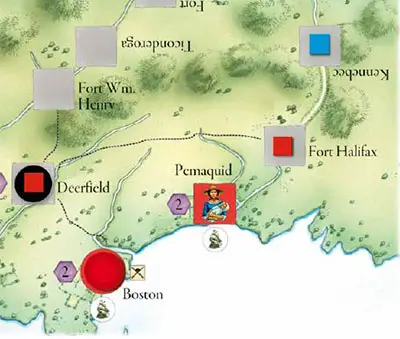
In this example Deerfield has been fortified. The French player could now only raid Fort Halifax or Pemaquid. Note that it would not be possible to raid Boston via Pemaquid.
You can regain control of a location that you have still have a location card for by taking the 'settle a location' action

Ambush
You play one card that has the ability to ambush. The other player may now block this with a card that states that it can do this.
This card must be played from the hand, not the reserve. The card used to block an ambush is placed onto the player's discard pile. Your opponent does not have to pay to use a Native Americans' card to block you.

If the ambush is not blocked then the opposing player must select one card that is marked with the 'ambush' symbol (as shown here) from either his hand or his reserve and place it back on his empire deck.
If a player has to lose a card from a siege then he must adjust his strength on the siege strength track according to the military strength of the ambushed card.
If your opponent does not have a card that can be ambushed then he must prove that by showing you clearly the cards in his hand. He would then not lose a card.
Priest/Indian Leader
When you play one of these cards your opponent must give you one neutral Native Americans card from either his hand or his reserve. You then place that card onto your discard pile. If he does not have such a card then he must show you his hand clearly to prove that this is the case.
The French player cannot lose his blue bordered Native American card to a British Indian Leader card.

In this example Deerfield has been fortified. The French player could now only raid Fort Halifax or Pemaquid. Note that it would not be possible to raid Boston via Pemaquid.
You can regain control of a location that you have still have a location card for by taking the 'settle a location' action.
Financial Actions
Take Money
You play one location card and take an amount of money from the bank equal to the value indicated in the gold circle.

Merchant
You play one card with a ship symbol on it. You can then play one or two cards which have a gold symbol on and take the amount of money indicated.
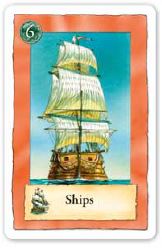
Trader
When you play the trader card you then play one or more location cards that have the fur symbol on them. For each such card that you play you take two money from the bank.
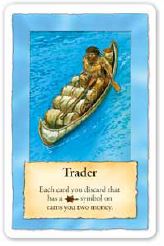
Piracy
This action is only available to the French player. You play the Louisbourg card and another card with a ship symbol on it. You then take two money from the British player. If the British player does not have sufficient money then you take any shortfall from the bank.
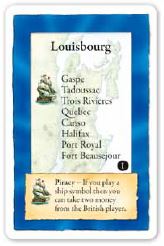
Card Managment Actions
Draft one empire card

You select one empire card from your available empire cards and place it onto your discard pile.
Check the card to see if you are required to pay any money to the bank. You can never take a card of your opponent's color, nor can you draft a location card. You cannot place location cards in your reserve.
E.g. If you drafted a neutral fortification card then you would have to pay three money to the bank.
Discard Card/s
You can discard one or more cards from your hand, placing them onto your discard pile. You can discard one card at no cost. If you then wish to discard more cards you must pay one money for each additional card discarded, e.g. if you discarded three cards you would have to pay two money.
Place a card in your Reserve

The reserve gives you the flexibility to place cards to one side so that you can pick them up later when they may be more useful. You select one empire card from your hand and place it face-up in the box marked 'Reserve'.
You can have up to five cards in your reserve. If you inadvertently go over this number and your opponent notices this he must select a number of cards from your reserve to bring the number down to five cards. These cards should be placed back with your available cards. You cannot place location cards in your reserve.
Retrieve Your Reserve
As a free action you can retrieve the cards in your reserve and place them back in your hand. You must pick up all of the cards in your reserve. You must pay one money for each card you retrieve.
Note that you can have more than five cards in your hand.
Governor

When you play the governor card you also select any one or two cards from your hand and return them to the available cards. This is a way for you to reduce the number of cards in your deck.
If you choose to remove a location card then you return it to your available location cards deck. If you choose an empire card then you return it to your empire card deck. If it is a neutral card then you return it to the neutral card display.
You can always regain a previously removed card in later turns if you wish. To regain a location card you would have to 'settle' the location again, including the playing of a settler symbol card if necessary.
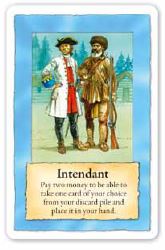
Intendant
If you play the intendant card then you pay two money to the bank (French intendants were notoriously corrupt) and then select one card of your choice from your discard pile and place it in your hand.
Home Support
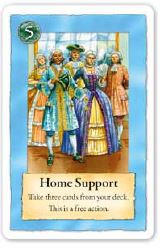
Playing your home support card is a free action. You draw three cards from your deck.
You can only draw those cards that are presently in your draw pile. If there are less than three then you draw the remaining cards, you do not shuffle the discard pile to make a new draw deck. Note that it would be possible for you to play this card, then an Intendant to pick it up again, and then play it for a second time in the same turn.
Other Actions
Withdraw From A Siege
You may choose to withdraw from a siege. You treat this as if you had lost the siege, i.e. you lose one empire card from those in your siege card space. The remaining cards are placed onto your discard pile.
Your opponent also places the cards from his siege card space back onto his discard pile. Remove the siege marker from the location. This is a free action. Both the attacker and defender have the option to withdraw from a siege.
Pass
Simply do nothing. Passing does not stop you performing more actions in later turns.
End of the Game
The British player wins immediately if he wins a siege or settles in Quebec. The French player wins immediately if he wins a siege or settles in Boston or New York. In the case of a siege it is not necessary for a cube to be placed in the location to trigger the victory condition.
Otherwise the game lasts until one of the end game conditions has been met, which are:
If there are no sieges in progress at the start of a player's turn and he has placed all of his discs OR cubes onto the board,
If there are no sieges in progress at the start of a player's turn and he has captured twelve points worth of cubes/discs from his opponent (a cube is worth two points and a disc is worth four points).
Each player now adds up the number of victory points he has. You score points as indicated for locations that you control, i.e. that you have a cube or disc in. If you have a disc in a location then you score double the number of points indicated.
You also score two points for each of your opponents cubes that you captured and four points for each disc you captured.
The player who has the highest total of victory points is the winner.
In the case of a tie then the French player is the winner.
Continue Reading
